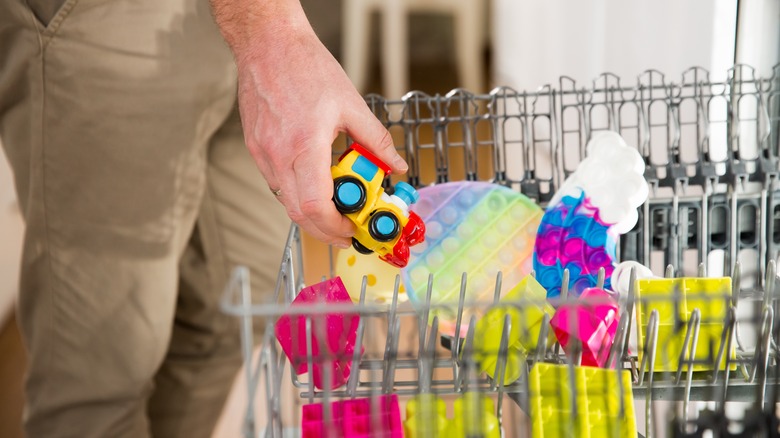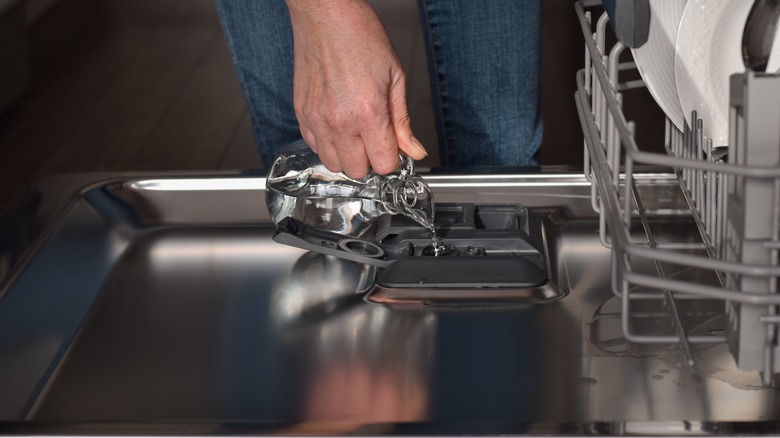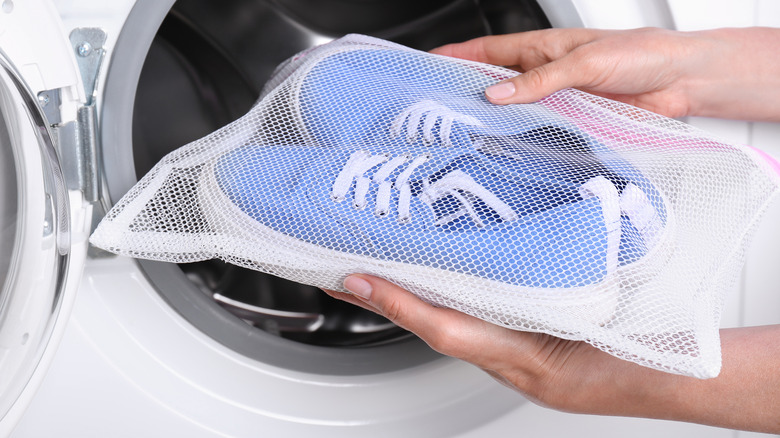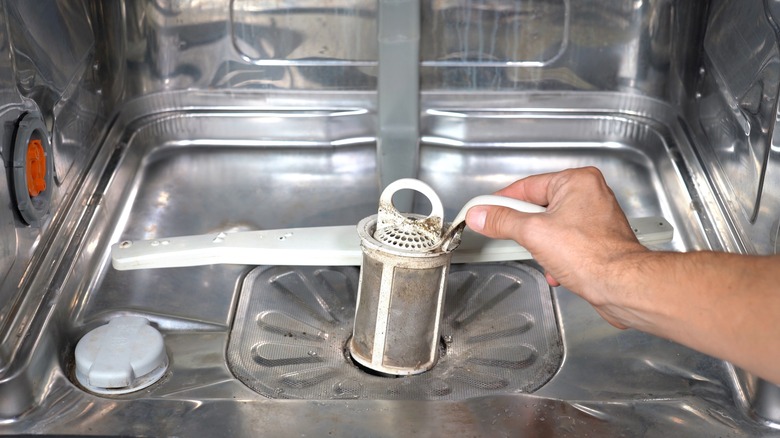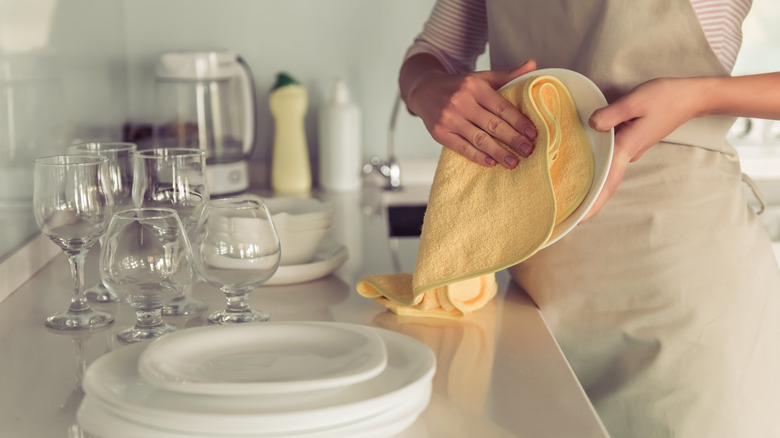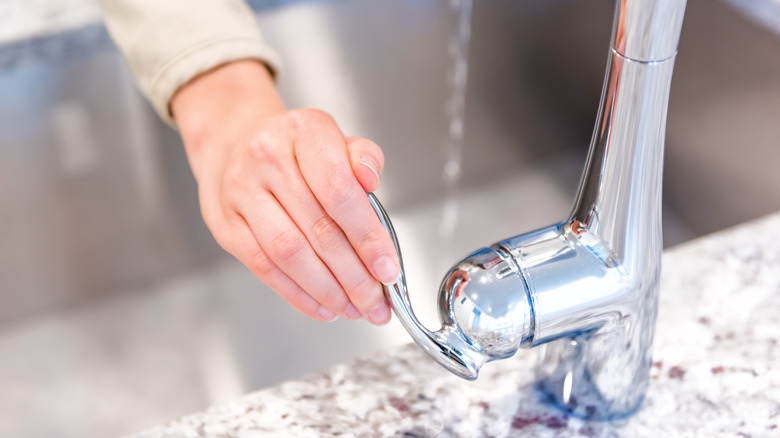8 Clever Dishwasher Hacks That Will Actually Make Your Life Easier
Your dishwasher is a useful appliance that can help you to take on a whole range of cleaning tasks for a variety of kitchenware items, including pots, pans, plates, and glassware. However, have you ever tried to use it for other things? Falling into a routine and overlooking clever dishwasher tricks that could make your cleaning routine easier are common traps. It's not about making more work for yourself, either. Instead, it's about embracing small ways to work smarter instead of harder and let your dishwasher give you a leg up.
Instead of thinking about the usual load it and start method, think about some of the common hacks you've seen. Many of them promise they'll upgrade your kitchen routine, but some fall short and can cause more trouble than they're worth. This is why we're taking time to take a longer look at some of the more useful dishwasher hacks out there.
Use the dishwasher to clean more than dishes
Using your dishwasher to clean things other than traditional dishware can help maximize time spent not cleaning. Pop a range of things into here to clean because they blast soap and hot water to sanitize, and it reaches temperatures that you can't get by handwashing. It's a great way to eliminate grime on glass light fixtures, plastic toys, and some metal shop or gardening tools. Also, its high drying temperatures help to sanitize items and kill more germs than traditional cleaning methods can.
To use your dishwasher better to clean non-dishware items, double-check that everything is dishwasher safe. Avoid putting things into it that the heat might warp or melt, like things with adhesive parts or delicate plastic items. Place smaller objects in a dishwasher-safe container to prevent them from getting flung about by the water's sprays or dropping to the bottom. Keep the cookware apart from these objects to avoid cross-contamination. When you run a cycle, use a mild detergent and pick a slightly lower temperature setting to protect fragile items. Things with batteries, electronics, or things that come with instructions to clean them by hand should never go into the dishwasher to avoid damage. Always double-check this before you add something.
Periodically use vinegar as a rinse aid to prevent cloudiness
Adding vinegar to the dishwasher as a rinse aid is a neat trick to stop your dishes and glasses from getting that nasty cloudy film, but is it safe to use without worrying about damage? The short answer is yes. As you use the dishwasher, hard water minerals build up on your dishes, making them look foggy or dull. Vinegar contains acetic acid, which slowly breaks down mineral deposits to ensure everything looks sparkly and clean. It's an eco-friendly, safe alternative to commercial-grade rinse aids, which usually have chemicals in their makeup. It uses vinegar's acidic nature to tackle the problem, enhancing how well your dishwasher works and ensuring your dishware lasts longer. It's also a simple solution.
To try this hack, put a cup of vinegar on your dishwasher's rack in an empty machine and run a normal cycle. Before you do, ensure that your dishwasher's warranty doesn't caution you against this, or you could accidentally void your warranty. Also, if your appliance has a rubber seal, limit how often you do this because the acetic acid can damage it. And go into this hack with reasonable expectations. It may work well, but it may not be strong enough if you have challenging water issues. If so, consider adding a water softener to the vinegar to combat mineral buildup.
Use a mesh laundry bag to safeguard small items
Using a mesh laundry bag in the dishwasher to safeguard small items is popular because it ensures things won't rattle around. It's easy for small items to slip through the racks, land on the bottom, and block the spray arms or get damaged. A mesh laundry bag allows water and detergent to get through to whatever you put in there to clean them while stopping them from falling. This hack helps ensure that everything from small lids to teaspoons gets cleaned without damage. The bag's material is the key to this trick because it's durable enough to survive the high temperatures in the appliance while ensuring anything you put inside it comes into contact with the detergent and water.
Put your small items inside of the bag and secure it before finding a spot on your dishwasher's top rack to lay it. This spot ensures the bag doesn't block the water spray from hitting the dishes below it. Everything in the bag needs space to move slightly to get clean, so don't pack it. Remove the whole bag at the end of the cycle and put your items away. Avoid using this hack with anything that needs more direct water pressure to clean, like utensils with dried-on food or heavily soiled things. Check your bag every few cycles for tears and replace it as needed so things don't fall out.
Use a toothpick to periodically clean the sprayer arm nozzles
There is a quick, clever toothpick hack that'll keep your dishwasher running like new, and you can do it without any special tools. Food particles, debris, and mineral deposits slowly build up as you use the dishwasher and coat the sprayer arms, eventually clogging the nozzles. When these nozzles get blocked, water can't come out and spray the dishes to clean them. Each nozzle has to work because it's how the appliance guarantees water gets evenly distributed throughout all of your dishware. A toothpick is the perfect size to gently get rid of any blockages without damaging anything, and it's a great way to ensure you boost your water usage and get an effective spray pattern with each load. Doing this once every few months ensures your dishwasher runs at peak performance.
To clean the sprayer arm nozzles using a toothpick, empty the dishwasher and switch it off. The sprayer arms are usually under each rack. Gently poke your toothpick into each nozzle, wiggling it around to dislodge any stuck gunk. Run water over the sprayer arms when you finish to flush out any particles you have loose. Work carefully so you don't accidentally snap the toothpick off in the sprayer nozzle and make this into a bigger project for yourself. Also, look at the manual because some manufacturers recommend specific maintenance steps and don't want you sticking things into the nozzles, which may void your warranty.
Use a terry cloth towel to absorb excess moisture and dry dishes
A terry cloth towel is a great option for drying your kitchenware. Terry cloth is a cotton material with loops that increase its surface area. This fabric is excellent for drying dishes because it quickly soaks up water, leaving your dishes streak and water spot free. The towel's texture and material are key to this hack because they can lock in a great deal of water without dripping. This is especially useful when drying things that collect water, like plastic cups or containers with recessed bottoms.
To use this towel to help dry dishes, crack the dishwasher door open when it finishes drying and insert your towel roughly one-third of the way inside the dishwasher. Leave it alone for 10 minutes before you open the door and pull out your dishes. The towel will absorb much of the excess moisture left in the dishwasher. Then, you can put your dishes away or lay any damp ones out on a clean, flat surface. Gently blot and wipe the remaining wet spots with your towel to remove the water. Ensure you don't rub too hard to avoid leaving fuzzy lint behind and switch out to a dry section as you work. When everything is ready, put your dishes away and lay the towel out to dry. Note that these towels can trap bacteria if you don't wash them regularly, so toss them into the washing machine after every few uses.
Create a loading strategy for a more efficient clean
Having a loading strategy in mind, mainly to keep your spatulas and spoons secure, can make your appliance more efficient. If you don't correctly put these larger items into the dishwasher, they can fall through the racks onto the bottom and block the sprayer arms. This stops the water from circulating correctly and prevents the water and detergent from hitting all your dishes. By putting these items on the top rack away from the dishwasher's moving parts, you ensure that it washes them correctly. By threading a tine from the rack through your bigger utensils' handles, you can keep them secure. This boosts your dishwasher's interior space while ensuring the water and detergent circulate freely to every item.
For better effectiveness with this loading strategy, see which of your utensils have a hole in the handle, like spatulas or big serving spoons. When you load your dishwasher, put these items on the top rack by gently threading the rack's tine through the utensils' holes to prevent them from slipping. Ensure your utensils don't touch or stop the spray arm's movements. Also, ensure you don't overload the top rack or stack items because this prevents them from getting clean. Ensuring that your utensils aren't in the way of the door when you lay them on the racks is also a good idea.
Run your dishwasher at nonpeak times to save energy costs
Using the dishwasher during nonpeak times will help cut your energy costs. These hours are when the electricity demand drops, usually during the early mornings or nighttime. During these hours, utility companies charge less for electricity to encourage people to spread out their use. This helps prevent blackouts and avoids overloading your local power grid. When you use your dishwasher during these times, you'll pay a lower rate for all the electricity you use, which can add up on your utility bills. Also, because the dishwasher can use a decent amount of electricity, especially as it dries or heats, running it during nonpeak times reduces your household's energy consumption to make it more eco-friendly.
Should you run the dishwasher during the day or at night? To answer that, learn your utility's peak hours by looking at its website or calling its customer service line to figure them out. When you know them, run your dishwasher during those hours. Many modern dishwashers come with a delayed start option, which lets you set it to run hours later. Use it to run your appliance at the most cost-effective time. However, if you live in an apartment or shared housing, be mindful that running the dishwasher later or very early can be disruptive. The goal is to save on your utility bills without sacrificing cleanliness, which takes some planning.
Run hot water in the sink before starting a wash cycle
Running hot water for a few minutes in the kitchen sink before you run the dishwasher will make it clean better. Most dishwashers get hooked up to your home's hot water supply, which they use to wash dishes. When you start your dishwasher without running hot water beforehand, it fills with cold or lukewarm water because it takes time to heat. Starting with cold water makes it wash less efficiently, especially if it's trying to dissolve grease or cooked-on residue. By ensuring you start with hot water, you're giving your dishwasher a boost. The detergent will work at its peak from the start, enhancing your dishes' cleanliness. If the water heater isn't in your kitchen, this is even more important because the hot water will take longer to reach your dishwasher.
To use this hack, turn the hot water tap on in your kitchen before you run the dishwasher. Start the dishwasher when you feel the water is hot, switch off the tap, and run a cycle as you usually would. This fills your dishwasher with hot water from the start. However, if you're concerned about saving water or living in a space with water restrictions, be careful with this hack because you will waste a bit of water as the tap runs. Also, this hack works best if your dishwasher doesn't have a built-in water heater. You can still use it, but it won't have as much of an impact.

